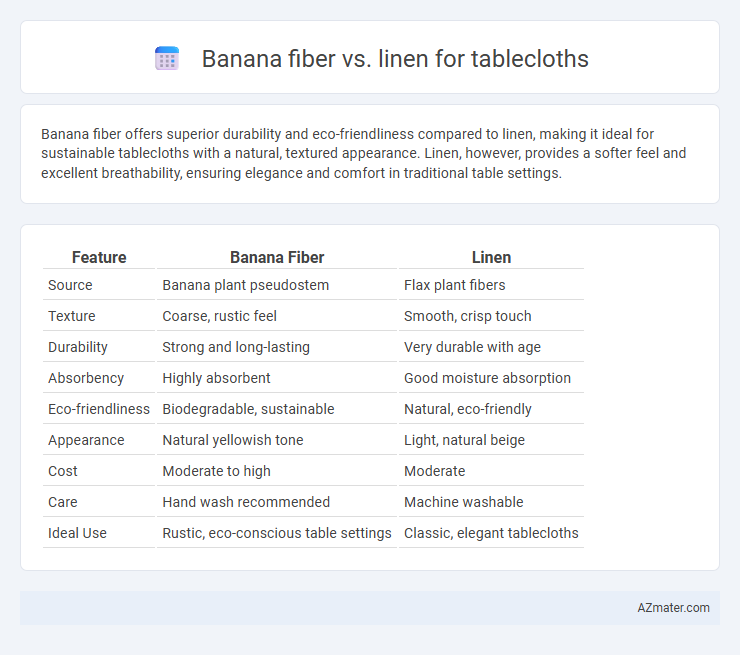Banana fiber offers superior durability and eco-friendliness compared to linen, making it ideal for sustainable tablecloths with a natural, textured appearance. Linen, however, provides a softer feel and excellent breathability, ensuring elegance and comfort in traditional table settings.
Table of Comparison
| Feature | Banana Fiber | Linen |
|---|---|---|
| Source | Banana plant pseudostem | Flax plant fibers |
| Texture | Coarse, rustic feel | Smooth, crisp touch |
| Durability | Strong and long-lasting | Very durable with age |
| Absorbency | Highly absorbent | Good moisture absorption |
| Eco-friendliness | Biodegradable, sustainable | Natural, eco-friendly |
| Appearance | Natural yellowish tone | Light, natural beige |
| Cost | Moderate to high | Moderate |
| Care | Hand wash recommended | Machine washable |
| Ideal Use | Rustic, eco-conscious table settings | Classic, elegant tablecloths |
Introduction to Banana Fiber and Linen
Banana fiber, derived from the pseudostem of banana plants, is a sustainable and biodegradable material known for its strength, natural luster, and moisture resistance. Linen, made from the flax plant fibers, is prized for its durability, breathability, and elegant texture, making it a traditional choice for high-quality tablecloths. Both fibers offer eco-friendly alternatives, with banana fiber standing out for its unique texture and linen for its classic smoothness and absorbency.
Origins and Production Processes
Banana fiber is derived from the stalks of banana plants, primarily grown in tropical regions like India and the Philippines, where the fibers are extracted through a manual or mechanical process involving retting and scraping. Linen, made from flax plants cultivated mainly in European countries such as Belgium and France, undergoes a more complex production process including retting, breaking, scutching, and heckling to obtain fine fibers. The sustainable extraction of banana fiber contrasts with the traditional and labor-intensive flax processing, which impacts the texture and durability of tablecloth materials.
Environmental Impact Comparison
Banana fiber, derived from the pseudostems of banana plants, offers a sustainable alternative to linen by utilizing agricultural waste and reducing deforestation pressures. Its production consumes less water and pesticides compared to linen, which is made from flax requiring intensive irrigation and chemical treatments. Choosing banana fiber for tablecloths significantly lowers environmental footprints through resource-efficient cultivation and biodegradability.
Texture and Appearance Differences
Banana fiber tablecloths feature a coarse, slightly rough texture with natural variations that create a rustic, organic appearance, whereas linen offers a smooth, crisp feel with a refined, elegant look. Banana fibers have a matte finish with visible strands, contributing to a textured surface, while linen's tightly woven fibers produce a uniform, polished surface with subtle sheen. The natural color of banana fiber ranges from creamy beige to light brown, contrasting with the lighter, often off-white or pale gray hues typical of linen fabrics.
Durability and Longevity Analysis
Banana fiber exhibits exceptional durability due to its high tensile strength and natural resistance to wear, making it ideal for long-lasting tablecloths. Linen, known for its strong flax fibers, offers excellent longevity with repeated use and washing, maintaining its texture and appearance over time. When comparing the two, banana fiber tablecloths tend to withstand moisture and stains better, while linen provides superior breathability and softness.
Stain Resistance and Maintenance
Banana fiber exhibits superior stain resistance compared to linen, as its natural waxy coating repels liquids and prevents quick absorption, making spills easier to clean. Maintenance of banana fiber tablecloths is relatively low, requiring gentle hand washing or delicate machine cycles to preserve texture and durability. Linen, while durable and breathable, is more prone to staining and often demands prompt treatment with stain removers and more frequent laundering to maintain its appearance.
Cost and Market Availability
Banana fiber tablecloths generally cost more than linen due to limited production and niche market demand. Linen enjoys widespread market availability with a broad price range, benefiting from established supply chains and large-scale cultivation of flax. Cost-effective linen options dominate retail outlets, while banana fiber remains a premium choice for eco-conscious consumers.
Comfort and Feel on the Table
Banana fiber offers a unique, natural texture with a soft yet slightly coarse feel, providing a rustic and organic appeal for tablecloths. Linen is celebrated for its smooth, breathable, and crisp touch, delivering a cool and refined elegance on the table. Both fibers enhance comfort, but linen's lightweight and softer drape tend to create a more luxurious tactile experience compared to the firmer, earthier feel of banana fiber.
Style Versatility for Table Settings
Banana fiber offers a unique, natural texture that brings an earthy, rustic charm to table settings, complementing both casual and eco-friendly themes with its organic appeal. Linen provides classic elegance with a smooth, refined finish, making it ideal for formal or minimalist table settings where crispness and sophistication are key. Both materials enhance style versatility: banana fiber suits eclectic or bohemian decors, while linen adapts seamlessly to traditional and contemporary designs.
Choosing the Best Material for Your Tablecloth
Banana fiber offers a unique texture and eco-friendly qualities, making it a sustainable and durable choice for tablecloths compared to traditional linen. Linen excels in breathability and smoothness, providing a classic look with high absorbency and easy maintenance. Choosing between banana fiber and linen depends on your preference for sustainability and texture versus timeless elegance and softness.

Infographic: Banana fiber vs Linen for Tablecloth
 azmater.com
azmater.com